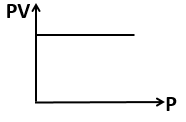The number of molecules present in 1 mL of gas or vapor at STP is:
1. called Loschmidt's number
2. equal to 2.617 x 1019 per mL
3. both (1) and (2)
4. none of the above
Air at sea level is dense. This is a practical application of:
1. Boyle's law
2. Charles' law
3. Avogadro's law
4. Dalton's law
In van der Waals' equation of state of the gas, the constant 'b' is a measure of:
1. Intermolecular collisions per unit volume
2. Intermolecular attraction
3. Volume occupied by molecules
4. Intermolecular repulsions
For 1 mole of gas, the average kinetic energy is given as E. The urms of gas is :
1. [2E/M]1/2
2. [3E/M]1/2
3. [2E/3M]1/2
4. [3E/2M]1/2
600 cc of a gas at a pressure of 750 mm is compressed to 500 cc. Taking the temperature to remain constant, the increase in pressure is:
1. 150 mm
2. 250 mm
3. 350 mm
4. 450 mm
The curve that can not represent Boyle's law is -
1.
2.
3.
4.
The deviation of a gas from ideal behavior is expected to be minimum at -
1. 350 K and 3 atm
2. 550 K and 1 atm
3. 250 K and 4 atm
4. 450 K and 2 atm
An ideal gas expands according to PV=constant. On expansion, the temperature of the gas:
1. Will rise.
2. Will drop.
3. Will remain constant.
4. Cannot be determined because the external pressure is not known.
The correct statement for an ideal gas equation is -
1. n is the number of molecules of a gas.
2. V denotes the volume of 1 mole of the gas.
3. n moles of a gas has a volume V.
4. p is the pressure of the gas when only one mole of the gas is present.
The gas among the following that can be most steadily liquefied is -
1. NH3
2. Cl2
3. SO2
4. CO2










